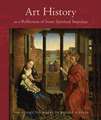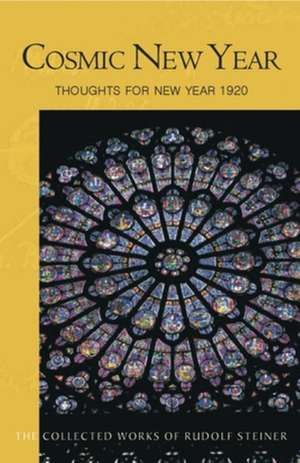Cosmic New Year: 5 Lectures Held in Stuttgart, December 21, 1919-January 1, 1920: Collected Works of Rudolf Steiner, cartea 195
Autor Rudolf Steiner Christopher Bamford Traducere de Peter Clemmen Limba Engleză Paperback – 30 noi 2007
- Introduction by Christopher Bamford
- 1. STUTTGART, DECEMBER 21, 1919: The three streams of cultural life: The Mysteries of The Light, of the Human Being, and of the Earth. 1) Origin in the old Eastern spiritual life. Social impact of the old initiation. The scientific path from above to below. Increasing filtration in ancient Greece to the abstraction of our time. Represented in the social sphere by aristocracy and feudalism. 2) Origin of the rights life in the Egyptian mysteries. Its development in Roman times. Legalization of Christianity in the Roman Catholic Church. Represented in social life by the bourgeoisie. 3) Origin of the economic life in the Nordic mysteries. Festivals related to the economic life. The way upward from below. Examples: Newton, Darwin, Mill, Spencer, Hume. The three streams rolled up together in the cultural chaos of today. Goethe, Wilhelm von Humboldt. The Russian revolutionaries. Opponents of Anthroposophy: Domkapitular, Ferriere.
- 2. STUTTGART, DECEMBER 25, 1919: A Christmas lecture. The Michaelic way to Christ. Can we still be Christians? (David Friedrich Strauss.) The anti-Christian thoughts of Tirpitz and Ludendorff. Harnack s conception of Christ. The beginning of Michael s regency in 1879. Michael today. The cosmic lie of the freedom of nations. The past incarnation of Lucifer and the future one of Ahriman. The Christian way as a balance between these two powers. The Christmas festival. The need for a new revelation.
- 3. STUTTGART, DECEMBER 28, 1919: The mystery of the human will. The connection between the will and processes of destruction. Effects of the will and the course of nature. Lucifer s incarnation in ancient China. Eastern mysteries: their becoming abstract in Greek philosophy and fixed in phrases at the present time. The preparation for the incarnation of Ahriman. The erroneous interpretation of the Gospels as a means to prepare the incarnation of Ahriman.
- 4. STUTTGART, DECEMBER 31, 1919: The relationship of human life to the past and the future regarded as a mirroring process. Perception of the I as a result of the interruption of consciousness during the night time. The necessity for the new revelation. The present day as a kind of Cosmic New Year. The necessity for a new experience of Christ. Gogarten s book Spiritual Science and Christianity. The attacks of the Jesuit Zimmermann. After the Cosmic New Year there must come a new year of the spiritual future.
- 5. STUTTGART, JANUARY 1, 1920: Rudolf Steiner s early essay The Spiritual Signature of the Present. Fichte and Hegel. The dogma of revelation and the dogma of mere sense experience. Lenin s social ideas. Spiritual science strives for a social order in which a balance exists between capacities and needs, i.e., between Lucifer and Ahriman. The characteristics of present East European culture (Lenin, Trotsky) with regard to the social sphere. In Middle Europe, the denial of the German spiritual life represented by Goethe and Schiller. Heinrich Deinhardt.
Din seria Collected Works of Rudolf Steiner
-
 Preț: 136.35 lei
Preț: 136.35 lei -
 Preț: 215.68 lei
Preț: 215.68 lei -
 Preț: 277.41 lei
Preț: 277.41 lei -
 Preț: 154.46 lei
Preț: 154.46 lei -
 Preț: 151.75 lei
Preț: 151.75 lei -
 Preț: 260.45 lei
Preț: 260.45 lei -
 Preț: 258.76 lei
Preț: 258.76 lei -
 Preț: 108.47 lei
Preț: 108.47 lei -
 Preț: 136.86 lei
Preț: 136.86 lei -
 Preț: 115.84 lei
Preț: 115.84 lei -
 Preț: 136.49 lei
Preț: 136.49 lei -
 Preț: 135.09 lei
Preț: 135.09 lei -
 Preț: 108.26 lei
Preț: 108.26 lei -
 Preț: 110.47 lei
Preț: 110.47 lei -
 Preț: 101.01 lei
Preț: 101.01 lei -
 Preț: 143.00 lei
Preț: 143.00 lei -
 Preț: 258.66 lei
Preț: 258.66 lei -
 Preț: 101.17 lei
Preț: 101.17 lei -
 Preț: 151.68 lei
Preț: 151.68 lei -
 Preț: 121.95 lei
Preț: 121.95 lei -
 Preț: 115.58 lei
Preț: 115.58 lei -
 Preț: 257.55 lei
Preț: 257.55 lei -
 Preț: 152.25 lei
Preț: 152.25 lei -
 Preț: 152.00 lei
Preț: 152.00 lei -
 Preț: 136.86 lei
Preț: 136.86 lei -
 Preț: 224.10 lei
Preț: 224.10 lei -
 Preț: 225.17 lei
Preț: 225.17 lei -
 Preț: 259.91 lei
Preț: 259.91 lei -
 Preț: 217.78 lei
Preț: 217.78 lei -
 Preț: 184.77 lei
Preț: 184.77 lei -
 Preț: 194.89 lei
Preț: 194.89 lei -
 Preț: 280.29 lei
Preț: 280.29 lei -
 Preț: 135.88 lei
Preț: 135.88 lei -
 Preț: 153.89 lei
Preț: 153.89 lei -
 Preț: 152.86 lei
Preț: 152.86 lei -
 Preț: 135.32 lei
Preț: 135.32 lei -
 Preț: 145.05 lei
Preț: 145.05 lei -
 Preț: 151.47 lei
Preț: 151.47 lei -
 Preț: 258.37 lei
Preț: 258.37 lei -
 Preț: 152.25 lei
Preț: 152.25 lei -
 Preț: 115.98 lei
Preț: 115.98 lei -
 Preț: 216.88 lei
Preț: 216.88 lei -
 Preț: 226.35 lei
Preț: 226.35 lei -
 Preț: 151.47 lei
Preț: 151.47 lei -
 Preț: 154.81 lei
Preț: 154.81 lei -
 Preț: 217.05 lei
Preț: 217.05 lei - 5%
 Preț: 145.87 lei
Preț: 145.87 lei -
 Preț: 151.75 lei
Preț: 151.75 lei
Preț: 100.76 lei
Nou
Puncte Express: 151
Preț estimativ în valută:
19.28€ • 20.18$ • 15.95£
19.28€ • 20.18$ • 15.95£
Carte indisponibilă temporar
Doresc să fiu notificat când acest titlu va fi disponibil:
Se trimite...
Preluare comenzi: 021 569.72.76
Specificații
ISBN-13: 9780880106139
ISBN-10: 0880106131
Pagini: 105
Ilustrații: frontispiece
Dimensiuni: 155 x 233 x 10 mm
Greutate: 0.21 kg
Editura: Steiner Books
Seria Collected Works of Rudolf Steiner
ISBN-10: 0880106131
Pagini: 105
Ilustrații: frontispiece
Dimensiuni: 155 x 233 x 10 mm
Greutate: 0.21 kg
Editura: Steiner Books
Seria Collected Works of Rudolf Steiner
Notă biografică
Rudolf Steiner (1861-1925) was born in the small village of Kraljevec, Austro-Hungarian Empire (now in Croatia), where he grew up. As a young man, he lived in Weimar and Berlin, where he became a well-published scientific, literary, and philosophical scholar, known especially for his work with Goethe's scientific writings. At the beginning of the twentieth century, he began to develop his early philosophical principles into an approach to systematic research into psychological and spiritual phenomena. Formally beginning his spiritual teaching career under the auspices of the Theosophical Society, Steiner came to use the term Anthroposophy (and spiritual science) for his philosophy, spiritual research, and findings. The influence of Steiner's multifaceted genius has led to innovative and holistic approaches in medicine, various therapies, philosophy, religious renewal, Waldorf education, education for special needs, threefold economics, biodynamic agriculture, Goethean science, architecture, and the arts of drama, speech, and eurythmy. In 1924, Rudolf Steiner founded the General Anthroposophical Society, which today has branches throughout the world. He died in Dornach, Switzerland.
